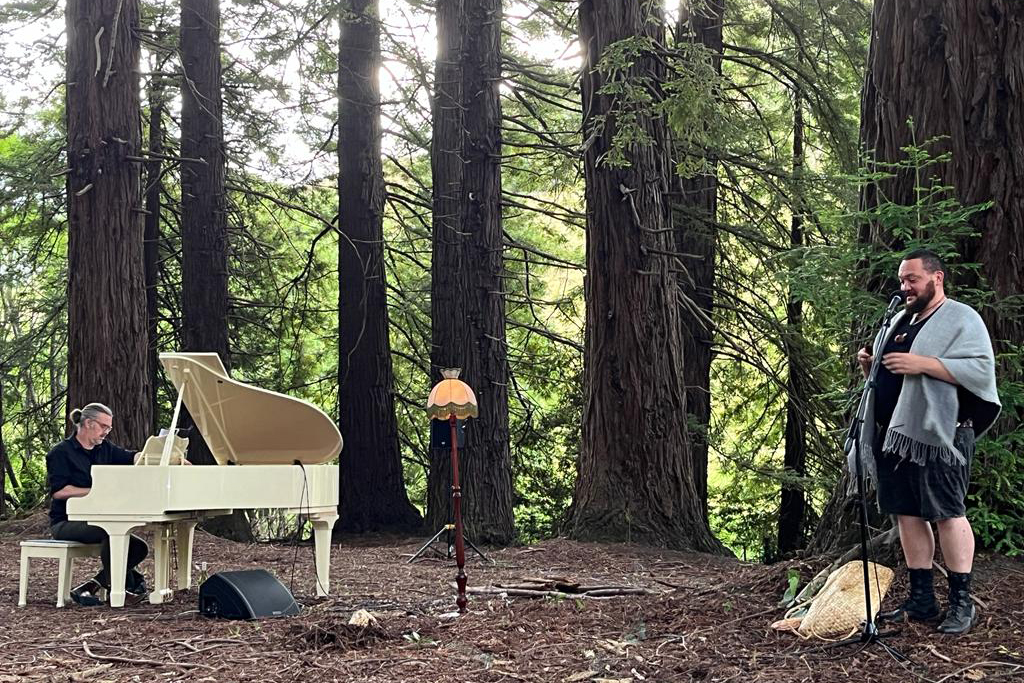A steady beat of feet treads the muddy trail, down through valley and up over hill, to Te Mata Peak’s Big Redwoods under a mercifully dry Friday early evening sky. Friends and whanau bring picnic blankets and snacks, taking little ones by the hand and the elderly by the elbow. We’re on a hikoi with purpose towards the promise of something beautiful, unique and new.
Nō whea koe Sequoia? is the latest adventure of Undergrand, the by now beloved travelling baby grand piano, transported by the magic of hydraulics, determination, and a can-do man with a very large van. A marriage of music, story and song, culture, education and activism, the piece is a collaboration between local giants – musical savant Anton Wuts, and esteemed historian storyteller Charles Ropitini.
Hopefuls emerging into the woodland clearing via a plethora of pathways are greeted by a whimsical scene. Wuts already tinkling on the keys. An old fashioned standard lamp seemingly sprouted, Narnia-like, from the forest floor. Old friends embrace while children run free, damming the creek and swinging from the behemoth trees. Native birdsong echoes across the valley.
Ropitini, or Tiāre as the blurb names his character, emerges from behind a leviathan tree trunk carrying a kete laden with promise. He warms us up with a waggish yarn regarding a questionably obtained car Joseph and Charles took on tour. Thus we are primed for story.
The scene is set in time and place, flowingly bilingually. Though the western calendar denotes the year’s turn, the Māori year is halfway through. We are in Kohitātea, the lunar month when the berries turn to seeds, but also the optimum time for planting one’s own seeds, should one want to conceive a baby to be born as the weather turns warm. Clouded in reo, Ropitini leaves easter eggs for native speakers in his kōrero.
Armed with a sheaf of kawakawa, pleasingly perforated, he alludes to its use as rongoā, kaputī, and the embargo the Trust has placed on its removal from the park. There’s thorny history here. This whenua passed through various indigenous tribal hands, sometimes by violence, before its purchase from the crown by the Chambers family, some of whom are in attendance. This redwood grove was planted by them in 1926, the year before it was gifted in perpetuity to the community, with caveats around its use.
Though they have stood almost a century, some with trunks that would take a small family to span, they are in their infancy in comparison to their potential lifetime. Some of their Californian kin have lived to over 3,000 years and are the largest trees in the world.
The meat of the storytelling is given over to the tale of the eponymous Sequoia, the Cherokee who gave these trees their name, and created the first indigenous syllabary. It’s a compelling tale touching on relevant themes of disability and addiction, deforestation and disenfranchisement. Ropitini emphasises the power of the written word alongside oral tradition, of being able to treat with colonists in terms they can understand, as well as the futility of expecting equality from a system founded on manifest destiny, the belief in natural white supremacy.
Tendrils of Māoridom weave through this two hundred year old chronicle of how Native Americans adapted their culture in order to survive. The euphonious strains of Wuts’ emotive accompaniment resound through the trees in harmony with the dusk chorus of bird call.
Story is interspersed with song. After a lilting introduction on kōauau, Ropitini raises his booming voice to the upper echelons of the canopy. His waiata, Hirini Melbourne’s Ngā Roimata, “the tears”, obliquely references the Trail of Tears, the deadly forced migration of native tribes that claimed thousands of lives, in contravention of the Supreme Court ruling that recognised the sovereignty of the Cherokee Nation.
He speaks of treaties written and treaty regret, of treaties honoured and treaties ripped up. He addresses the masses with passionate diatribes on cultural preservation, how we must protect what we have – culture and environment, language and people. This is true cultural communion, a genuine conversation, allowing one indigenous story to inform another. Wuts carries the spirit of Ropitini’s words in melody that resonates in the evening air and the hearts of everyone who has the privilege to be there.
It ends, not with karakia but polite white applause. Ropitini melts away into the bush making us wonder was he ever really there or was he a mere figment of our collective imagination? Surely such magic could not be real.
As dusk falls the convivial chatter of the crowd melds with bird calls. The procession snakes back up the track in single file, taking in with reverent awe all we have seen and heard, all we have learned, and all we dare to begin to imagine for the new future we get to go forth and create.
Nō whea koe Sequoia? was gifted free of charge to the community by Hastings District Council’s Creative Communities Fund, Te Mata Trust, Bruno Chambers, Charles Ropitini and Anton Wuts and collected koha for Te Mata Trust.
Photo: Jenny Cross

